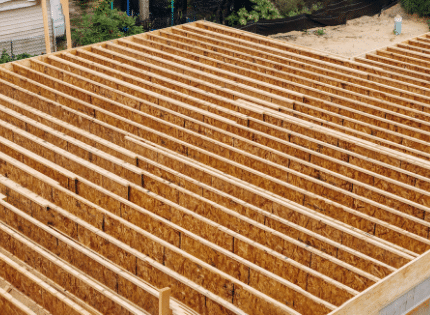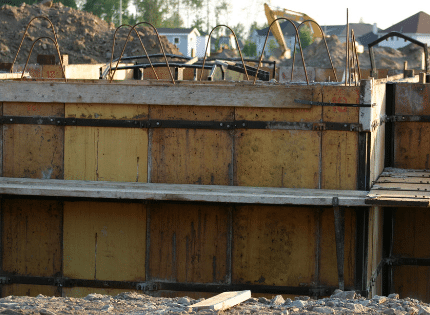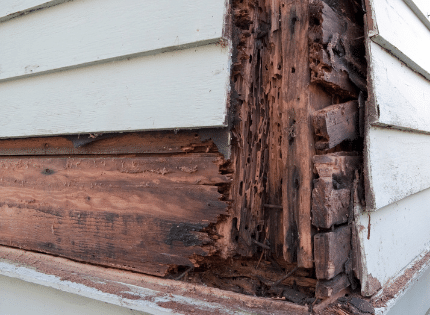Curious about wood foundations? Great! RegionalFoundationRepair is at your service 24/7. In this guide, we cover common questions like:
- What Are The Different Types of Wood Foundations?
- What Are The Benefits and Advantages of Wood Foundations?
- What Are The Common Problems of Wood Foundations?
- What Are The Correct Conditions for a Wood Foundation?
For a quick pricing quote on wood foundation repair or installation, tell us about your project in the form. We’ll get you connected with one of our foundation repair technicians in your city, or continue reading to learn about wood foundations.
What Is A Wood Foundation?
A permanent wood foundation (PWF) is a home foundation made out of pressure-treated wood. We begin the construction process just like we would for a poured concrete foundation: with proper excavation, removal of organic material, and land gradation.
Most wood foundation systems still use a concrete slab as the floor for the basement, so we will pour the basement floor before moving onto the load-bearing walls. If a wood floor is preferred, we’ll place a wood footing that will act as the slab for your home.
Next, we use moisture-resistant wood to build out the framing for your basement walls.
During the construction process, we take great care to add additional waterproofing material to the exterior of the wood walls, such as waterproof sheathing, corrosion-resistant fasteners, and professional-grade caulking.
Even pressure-treated lumber can rot when exposed to moisture for long periods, so added protection is crucial to extend the longevity of a PWF system. We go the extra mile on all of our installations to mitigate the risk of rot as much as possible.
Once we’ve finished constructing the wood walls with proper spacing and load distribution, we can start building the first floor of your home.
Wood foundation walls have proven to be a good and sturdy alternative to poured concrete and concrete block foundations, but we still take extra precaution when backfilling and compacting the soil around the new foundation. This step ensures that the walls we’ve built will resist the inward pressure from the ground, especially when it gets wet and expands.
Construction Pros
Wood foundations have been under great scrutiny since they originated in the 1960s, but there are many benefits to wood foundation construction.
Perhaps the most significant construction benefit is the significantly lower cost than poured concrete or concrete blocks in certain situations. Generally, wood foundations are more expensive, but they’re ideal for remote locations where it would be difficult or costly to transport concrete materials.
We can install wood foundations in a much shorter timeline than a concrete base, so your total project time will be significantly shorter if you choose to build with wood. You also won’t be limited by weather during the construction process. Our concrete foundation projects are regularly put on hold because of rain, but we can safely install a wood foundation in any weather condition.
Construction Cons
Of course, there are some downsides to wood foundations as well, the most significant of which is the average cost. Unless you’re constructing your home in a location where it would be very costly to transport concrete or cement blocks, a wood foundation will be significantly more expensive.
The wood that we must use to help maintain your foundation’s integrity is also treated with chromated copper arsenate (CCA), a preservative that can be dangerous to our technicians during construction. Some homeowners have concerns that the wood is hazardous once the foundation is installed, which are warranted. However, the biggest threat is to our foundation construction specialists. We require protective gear throughout the process to keep our team members safe.
Lastly, the building code in many areas doesn’t allow for wood foundations, so you may be limited by your municipality in some cases.
What Are The Correct Conditions for Wood Foundations?

Wood foundations aren’t ideal in all situations. The primary issue with foundations made out of pressure-treated lumber is that they’re prone to rot. Even wood treated with the proper chemicals can degrade over time if it’s exposed to moisture for extended periods. As such, they’re ideal for properties that are adequately graded to reduce runoff movement toward your structure.
Wood foundations are not suitable for properties near the water where groundwater could interact with the foundation frequently. This will cause rot over time and gradually decrease your foundation’s structural integrity.
Lastly, wood foundations are ideal for colder climates, as we can insulate them and drastically increase the R-value of your basement walls. This will result in less heat escaping from your basement, greater energy efficiency in your home, more comfortable air temperatures in your living space, and overall lower energy bills than you’d experience with a concrete foundation.
What Are The Types of Wood Foundations?

There are two different types of wood foundations, both of which we construct in very similar ways.
Wood Basement Foundation
A wood basement foundation is very similar in size, shape, and functionality to a standard concrete basement. We lay the wood footing plate or pour the concrete slab that will act as your basement floor at approximately 8.5 feet on a bed of gravel. We then construct 8-foot wooden walls using pressure-treated lumber on the slab or footing plate.
A wood basement foundation is ideal in areas where the frost line is below the depth of a slab or crawlspace. Plumbing lines must run below the level at which the ground freezes, so we generally construct wood basements in colder climates.
Wood Crawlspace Foundation
A wood crawlspace foundation is similar in the construction process to a basement, but we excavate far less soil and construct much shorter wooden walls. A wood crawlspace still provides space for storage and easy access for plumbing and electrical repair, but it cannot be used as additional living space as a basement could.
Wood crawlspaces are typically better suited for moderate climates where the frost line is too deep for slab foundations but not quite deep enough to justify the excavation for a full basement.
What Are The Benefits and Advantages of Wood Foundations?
There have been many skeptics of wood foundations, mainly because they’re a relatively new idea in construction. However, homeowners who hire us to construct wood basements and crawlspaces enjoy several key benefits over installing a concrete foundation.
Better Insulative Capability
One of the most significant pros is the ability to insulate your wooden foundation walls. Just like your upper floors, we can install insulative material between the wall studs and behind the drywall, drastically improving your basement’s ability to retain heat.
Insulation in your foundation walls increases their R-value, which means your basement will be significantly more energy-efficient. Homeowners who have wood foundations don’t experience the uncomfortably cold temperatures they often do in concrete basements.
Traditional concrete basements and crawlspaces represent a significant problem for maintaining indoor air temperatures because the heat from your home is often lost to the space below. Decreased heat loss means that you’ll ultimately be reducing your heating and cooling costs throughout your entire home, especially in extreme weather.
Easier to Finish
Many homeowners opt to finish their basement to add to their living space and or make the area a more pleasant place for storage. Finishing a concrete basement requires additional protection between your studs and the foundation walls, but framing can be attached directly to a wood foundation’s walls without any preparation.
Additionally, routing electrical and plumbing work behind your walls is significantly more manageable with a wood foundation. They can be placed behind the walls of a finished basement just as they would on your upper floors because there is naturally a cavity between the foundation walls and your sheetrock.
Flexibility
Wood foundations are significantly more straightforward to manipulate than concrete foundations. This means that altering your home’s footprint for additions and moving your home entirely after it’s built are both much easier and less expensive. They offer you some flexibility in how your home is set up and even where it’s situated.
Easier Utility Repairs & Home Inspections
Plumbing and electrical lines are commonly run through foundation walls to keep them safe and out of the way. As you can probably imagine, utility lines in concrete walls are significantly harder to access than those run inside wood foundation walls.
Utility repairs to lines in your basement or crawlspace will be just as simple as those on your upper floors. The walls are built with simple frame construction, allowing easy routing for utilities and straightforward access for repairs or home inspectors.
Green Construction
Wood foundations are considered “greener” than concrete because wood is a renewable energy source, while concrete can only be gathered and made out of existing materials. Homeowners looking to minimize their impact on the environment can do their part by hiring us to install a wood foundation rather than a concrete block or poured concrete base.
What Are The Common Problems of Wood Foundations?

While there are many benefits to wood foundations, there are some distinct drawbacks as well that may deter you from choosing one.
Exposure to Rotting
The biggest risk you face when choosing a wood foundation is exposure to rotting. We only use pressure-treated and chemically treated lumber in our construction to ensure the safest and longest-lasting wood foundation possible. However, even the best possible wood will rot in sub-optimal conditions.
We construct wood foundations only when appropriate for the land, with adequate moisture barriers, and comprehensive drainage systems like French drains and sump pump systems. However, moisture can still be a problem in the long run.
Exposure to Insects
Aside from the inherent issues with water in the soil, moist conditions also attract insects. In areas where termites and carpenter ants are particularly problematic, wood foundations will be more exposed than their concrete counterparts.
Wood-destroying insects (WDI) can slowly eat away at framing and floor joists even above concrete foundations, but they pose an additional threat to wooden basement walls. WDIs are of greatest concern for wood foundations because their presence may not be apparent until significant damage occurs.
We typically recommend that our customers treat the soil around their homes with an insecticide or termiticide to minimize the threat of insect infestation. In many cases, with the proper preventative measures, wood foundations can go many decades without an insect issue.
Expensive to Repair
Wood foundations may be relatively easy to adapt once constructed, but repairing sections that have been destroyed by rot or insects can be challenging, time-consuming, and very costly.
When concrete foundations are cracked or damaged, they can be stabilized and repaired while remaining under your home. If the wood below your home becomes rotted or damaged by insects, it can’t simply be reinforced. We need to remove the compromised wood entirely and replace it.
Additionally, moisture damage often requires that we excavate around your home to address the source of the issue. Once the exterior wall is exposed, the vapor barrier and caulking can be addressed to improve your foundation’s water resistance. We then backfill and compact the ground to avoid problems with soil expansion going forward. Excavation and backfilling are both very costly.
Lower Overall Strength
One of the most quoted negative aspects of wood foundations is their limited strength. As the base of your entire structure, you want your home’s foundation to be built with sturdy construction materials. While wood foundations are suitable for full-sized homes and don’t present any significant structural problems, wood will never be as strong as reinforced concrete. Many homeowners prefer to rely only on the most robust materials.
Questionable Longevity
Another common criticism of wood foundations is their unproven track record. Builders have been using concrete for thousands of years, and modern cement block and poured cement foundations have persisted for over a century. As such, homeowners trust the material and understand its potential for longevity.
On the other hand, permanent wood foundations were developed much more recently in 1960. Although structures have lasted since then, the construction practice is still considered a novelty, leaving homeowners unsure of its durability.
Wrapping Up
Wood foundations have some advantages over concrete alternatives, but no foundation type is without its potential problems. We use only the most appropriate building materials and waterproofing methods during wood foundation projects to mitigate the risks and highlight the benefits of wood construction.
If you’re looking to have a wood foundation built, repaired, or waterproofed, fill out the contact form, and we’ll have one of our dedicated foundation specialists reach out to you quickly.
